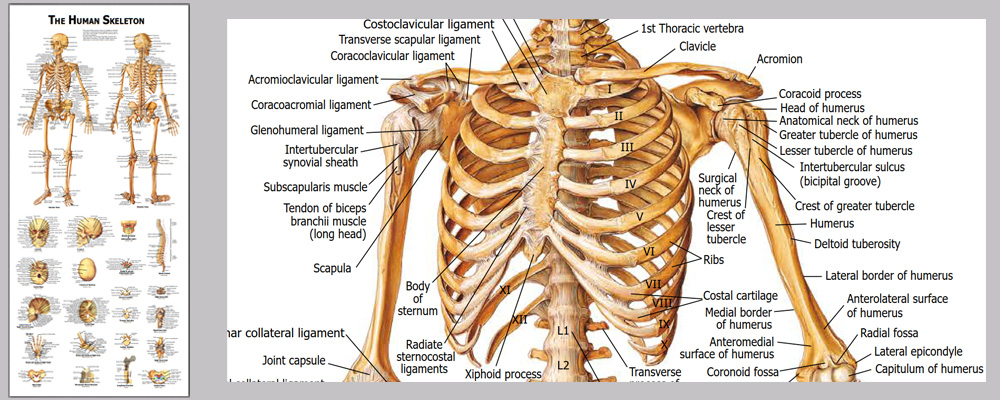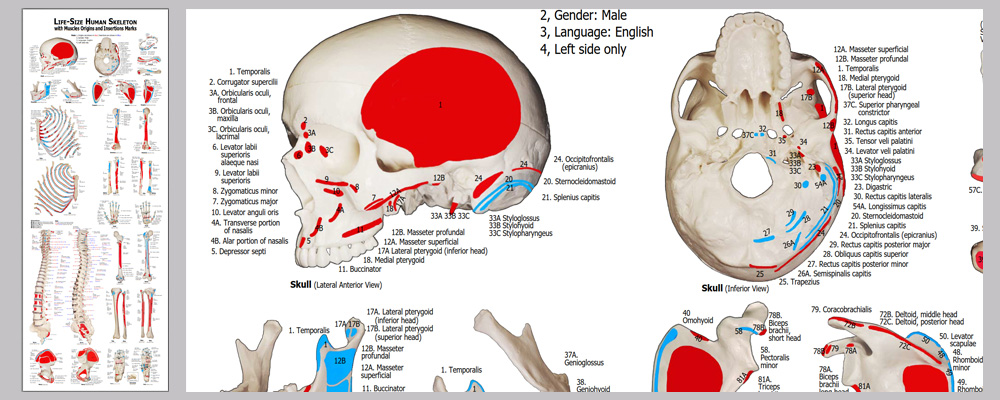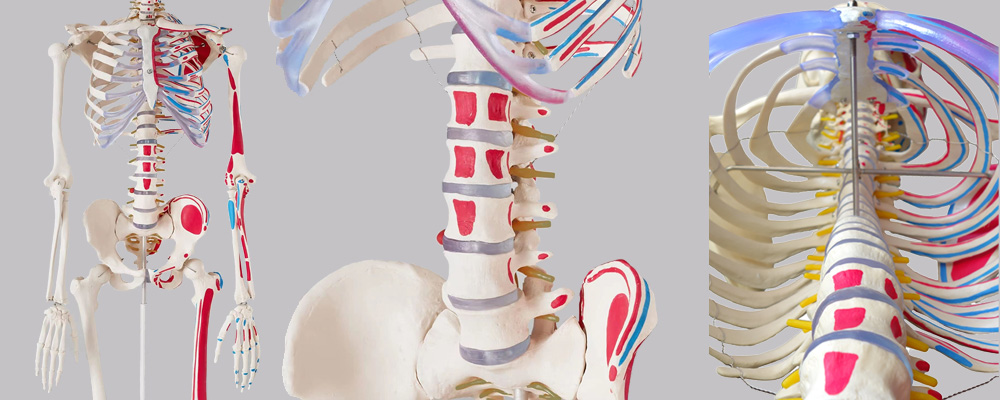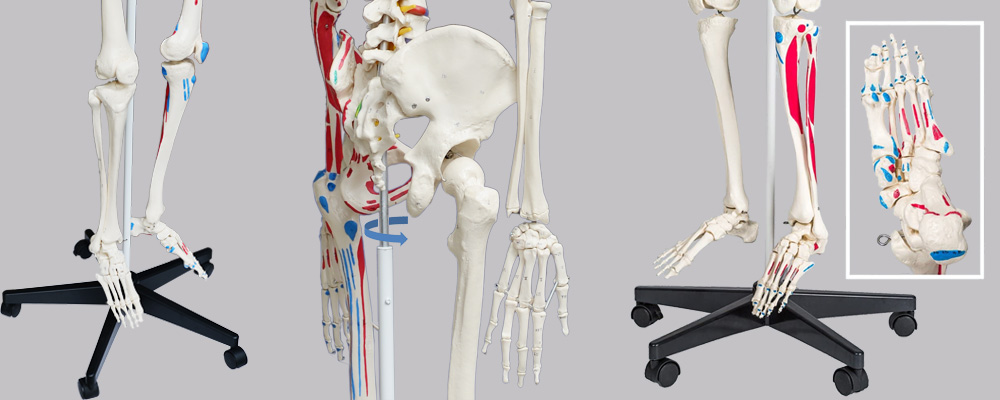life size anatomical human skeleton model
This life size articulated adult human skeleton model is 180cm tall & ideal for teaching / learning the basics of human anatomy. Includes a colorful Human Skeleton chart to show all the detailed structures for reference.Detailed colorful chart with over 630 accurate definitions. Durable and no reflection with matte film covered, 36 * 78cm

Detailed muscles origins and insertions with codes. Durable and no reflection with matte film covered, 100cm * 38cm

Stainless steel wires keep the ribs gaps stable.

2 of 5 casters are lockable.

With JC anatomy, you can also demonstrate the movements of the skull via the head joints, and thanks to the fully flexible spine, you can adjust the life size anatomical human skeleton model to place it in natural body postures. The unique combination of muscle origins and insertions, the numbered bones, flexible ligaments and flexible spine with a slipped disc between the 3rd and 4th lumbar vertebrae clearly the show medical and anatomical interest of this top model's more than 654 structures. Now available on a stable metal stand with 5 casters!
| Product name | life size anatomical human skeleton model |
| Place of Origin | Shenzhen China |
| Product Material | PVC, ABS, SST |
| Rib cage | A 5mm dia |
| Human skeleton model life | 15years |
| Surface treatment | Polish. Etched. Texture |
| SUPPORT 24/7 | Contact us 24 hours a day, 7 days a week |
| Size | 68 * 43 * 126 |
| Port | Shenzhen |
| PAYMENT & ORDERING | PayPal account or pay by credit card |
life size anatomical human skeleton model FAQs Guide Are you looking for a quick review guide about life size anatomical human skeleton model? An ultimate FAQs buying guide is available to help you.This guide contains all the information about all the important facts, figures, and various processes regarding life size anatomical human skeleton model. Let’s continue!
2.How to correctly assemble and utilize a life size anatomical human skeleton model?
3.Does this life size anatomical human skeleton model include all human skeletal systems?
4.Can this life size anatomical human skeleton model be used as an aid to human learning?
5.How many movable joints does life size anatomical human skeleton model have?
6.About life size anatomical human skeleton model production capacity
7.About life size anatomical human skeleton model warranty
8.About the scale of life size anatomical human skeleton model factory
9.About life size anatomical human skeleton model production equipment
10.How much does it weigh and is it easy to carry and maneuver life size anatomical human skeleton model?
11.life size anatomical human skeleton model Are accompanying labels provided indicating the name and location of each bone?
12.What aspects of bone structure can be observed in this life size anatomical human skeleton model?
13.How durable is life size anatomical human skeleton model?
14.What are the different types of life size anatomical human skeleton model available?
1.What kind of material is used to make the life size anatomical human skeleton model?
The human skeleton model is typically made out of a combination of materials, depending on the specific model and its intended use. Generally, the main materials used are plastic, metal, and sometimes, natural materials such as wood. Plastic: The majority of the skeleton model is made from a high-quality, durable plastic such as polyvinyl chloride (PVC) or polyethylene. These materials are lightweight and easy to mold into the intricate and specific shapes required for each bone in the skeleton. They are also easy to paint and can be colored to resemble real bones.
2.How to correctly assemble and utilize a life size anatomical human skeleton model?
When assembling and utilizing a human skeleton model, there are several steps to follow to ensure correct positioning and accurate representation of the skeletal system. Below is a step-by-step guide to properly assemble and utilize a human skeleton model: 1. Gather all the necessary components: The first step is to gather all the pieces of the human skeleton model, which typically includes a skull, rib cage, spinal column, arms, and legs. Make sure that all the pieces are present and in good condition. 2. Identify the bones: Before assembling the skeleton, it’s important to familiarize yourself with the different bones and their names. The skull, for example, has different parts such as the cranium, mandible, and maxilla, while the spinal column consists of the cervical, thoracic, lumbar, sacrum, and coccyx vertebrae. 3. Attach the arms and legs: Next, attach the arms and legs to the skeleton. Start by connecting the arms to the shoulder sockets and then attach the hand bones to the arms using the elbow and wrist joints. For the legs, connect the femur (thigh bone) to the hip socket, followed by the tibia and fibula (lower leg bones), and finally the foot bones.
3.Does this life size anatomical human skeleton model include all human skeletal systems?
It depends on the model in question. Some Human skeleton models may include all human skeletal systems such as the axial skeleton (skull, vertebral column, ribcage), appendicular skeleton (arms, legs, shoulder girdle, pelvic girdle), and cartilaginous skeleton (cartilaginous structures such as the nose and ears). However, others may only include certain systems or be limited to specific areas of the body. It is important to carefully read the product description or ask the manufacturer for a detailed list of what is included in the model to ensure that it meets your needs.
4.Can this life size anatomical human skeleton model be used as an aid to human learning?
Yes, this Human skeleton model can be used as an aid to human learning in various ways. It is a representation of the human skeleton, which is the framework of bones that supports the body and protects internal organs. This model can be used as a hands-on learning tool in classrooms, medical schools, and other educational settings. Firstly, it can be used to help students understand the structure and functions of the human skeleton. By examining the bones and their placement, students can learn about the different types of bones, such as long bones, flat bones, and irregular bones, and how they work together to facilitate movement and support the body. This model also allows students to visualize the various joints, their types and movements, and how they are connected to each other. Overall, this Human skeleton model can be a valuable tool in human learning as it provides a tangible and visual representation of the skeletal system. It allows for interactive and hands-on learning, making it easier for students to grasp complex concepts. With its versatility and usefulness in different disciplines, it can serve as an effective aid in enhancing human learning.
5.How many movable joints does life size anatomical human skeleton model have?
There are approximately 13 movable joints in the human skeleton model, with different types of joints including ball and socket, hinge, pivot, gliding, and saddle joints. These joints allow for a wide range of movements, such as flexion, extension, rotation, abduction, and adduction.
6.About life size anatomical human skeleton model production capacity
600pcs each month
7.About life size anatomical human skeleton model warranty
3 years. If any problem occurs with the model due to material or structural defects, it will be repaired or replaced free of charge to the buyer
8.About the scale of life size anatomical human skeleton model factory
Covering an area of about 2000 m². This would include manufacturing space for assembly, molding, and finishing processes, as well as storage space for raw materials and finished products.
9.About life size anatomical human skeleton model production equipment
The production of a human skeleton model requires a variety of specialized equipment to ensure accuracy, durability, and detail in the final product. we around 50 sets dedicated equipment
10.How much does it weigh and is it easy to carry and maneuver life size anatomical human skeleton model?
The Net weight is 8.8kgs (19.4lbs). It's easy to move with the 5 castors
11.life size anatomical human skeleton model Are accompanying labels provided indicating the name and location of each bone?
The stardard model does not provide this function. The chart shipped with pro model shows the name and location of each bone
12.What aspects of bone structure can be observed in this life size anatomical human skeleton model?
1. Long bones: The long bones of the skeleton model, such as the femur, tibia, and humerus, have a cylindrical shape and are longer than they are wide. They also have distinct features such as a rounded head at one end and an expanded area at the other end for attachment points of muscles and ligaments. 2. Short bones: The carpals in the wrist and tarsals in the foot are examples of short bones that are generally cube-shaped and are specialized for mobility and flexibility. These bones can be seen in the skeleton model as small, compact bones. 3. Flat bones: The flat bones of the skeleton, such as the skull, sternum, and scapula, are thin and flattened, providing protection for internal organs or attachment sites for muscles. These bones can be observed in the skeleton model as flat and smooth. 4. Irregular bones: The irregular bones, such as the vertebrae and pelvis bones, have complex shapes and vary in size and structure. The spine and hip bones can be identified on the skeleton model as examples of irregular bones.
13.How durable is life size anatomical human skeleton model?
The durability of a human skeleton model can vary depending on the materials used and the quality of construction. However, generally speaking, a high-quality skeleton model can be quite durable and can last for many years if properly cared for. Here are some factors that can affect the durability of a human skeleton model: 1. Materials: The most common materials used for human skeleton models are plastic, resin, and wood. Plastic and resin models are generally more durable as they are less prone to damage from impacts or moisture. Wood models can also be quite durable, but they may be more susceptible to wear and tear over time. 2. Maintenance: Proper maintenance and care can significantly increase the durability of a human skeleton model. Regular cleaning with a soft cloth and mild detergent can help keep the model free of dust and dirt. Additionally, storing the model in a protective case or covering can also help prevent damage. Overall, a high-quality human skeleton model can be quite durable and can last for many years with proper care. However, it is important to keep in mind that no model is completely indestructible, and regular wear and tear can occur over time.
14.What are the different types of life size anatomical human skeleton model available?
1. Anatomical Skeleton Models: These models are exact replicas of the human skeletal system and are used for educational and medical purposes. They are typically made of high-quality materials such as plastic or resin and come with detailed labels for each bone, making it easy to identify and study different structures. 2. Disarticulated Skeleton Models: These models consist of individual bones that can be separated from each other. They are often used in classrooms for teaching purposes as they allow students to handle and study each bone individually, facilitating a more hands-on learning experience. 3. Flexible Skeleton Models: These models are made from a flexible material such as rubber or PVC and are designed to mimic the movements of the human body. They are often used in medical training and rehabilitation settings to demonstrate muscle and joint movements. 4. Life-size Skeleton Models: As the name suggests, these models are the same size as an actual human skeleton. They are most commonly used in medical schools and hospitals for teaching and training purposes.




